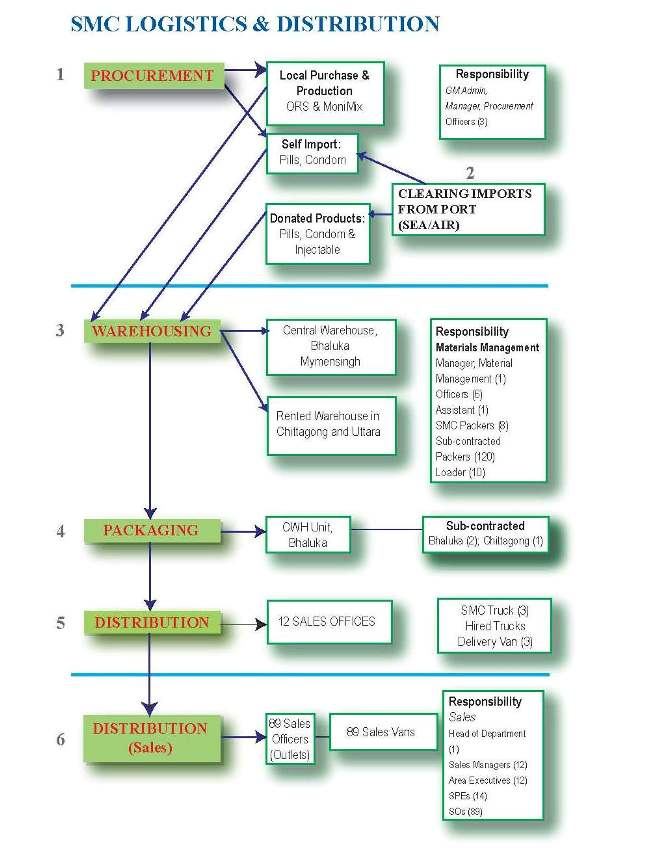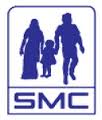SMC At a glance
SMC is regarded as the largest privately-managed not-for-profit organisation in the world for a single country. The Company is registered under the Companies Act, 1913 in Bangladesh and is governed by a voluntary Board of Directors.Social marketing in Bangladesh was initiated to challenge the rapid population growth by marketing contraceptive products widely accessible at a price affordable to the general population and bring about behavioural change through extensive mass promotion
SMC is now regarded as a significant contributor to the reproductive and child health services in Bangladesh by complementing the public sector distribution with private sector social marketing model. In 2011, SMC provided 3.49 million Couple Years of Protection (CYP) through offering three modern methods – oral pills, condoms and injectables. As BDHS shows, 35 per cent of the modern contraceptive users reported that they use SMC brands.
The new WHO formula-based packaged oral rehydration salt brand marketed by SMC called ORSaline-N was introduced in 2004.With the objective of becoming self-sufficient and receiving uninterrupted supply of ORSaline-N, SMC’s factory began its operation in August 2004 at Bhaluka, Mymensingh. Currently, the annual production capacity of the factory is 210 million sachets.
SMC is one of the pioneers of social and market research in Bangladesh. Every year, SMC sponsors and conducts a number of research studies to gather empirical data and necessary information in developing and evaluating its various projects and activities.
In 1990, the Family Planning and Social Marketing Project transformed into a not-for-profit private (Ltd.) company, which gave it a more comprehensive legal framework for operational flexibility. The Company is now governed by a voluntary Board of Directors. The Board of Directors consist of eminent personalities with private and public sector expertise in different fields.
SMC’s Vision
Social Marketing Company (SMC), Bangladesh is dedicated to providing opportunities for better family health for the people of our country by addressing issues of social priority.
SMC’s Vision to be the international model for sustainable social marketing built on the principles of cross subsidy using surplus funds from company’s business operations to support an expanded portfolio of program activities designed to achieve social good.
SMC’s Mission
SMC’s Mission is to improve the health and well being of women, childer and families by increasing demand for an expanding access to products and services in family planning, health, nutrition and other socially beneficial areas in partnership with the private sector, government and the donors.
SMC aims to become a more results oriented organization with a more efficient management structure, more open communication channels at all levels, sounder financial management and planning capabilities, and a satisfying work environment for all its staff capabilities, and a satisfying work environment for all its staff.
Product
SMC social markets a variety of oral pill brands (Combination 3, Noret-28, Femicon, Minicon and Femipil); and condoms (RAJA, HERO, Panther, Sensation, and U&ME); and clinical (Injectable “SOMA-JECT”) contraceptives.
The WHO formula-based packaged oral rehydration salt brand marketed by SMC called ORSaline-N was introduced in 2004. To provide choices to the consumers and to encourage children who are unwilling to take ORS, SMC introduced BNF-flavoured ORS brand ‘ORSaline Fruity’ in August 2003.
In May 2008, SMC introduced a micronutrient powder in the brand name of “MoniMix” to address childhood Iron Deficiency Anemia (IDA). It also started marketing Zinc dispersible tablets in September 2008 to reduce the severity of diarrhoea in children under 5. As part of its maternal and neonatal health programme, SMC launched Safe Delivery Kit branded as “Safety Kit” in 2008 to ensure clean child delivery at household level.
Product History
Hormonals: Oral Contraceptive Pill
| Maya | 1975 – 1995 |
| Ovacon | 1980 – 1996 |
| Norquest | 1990 – 1995 |
| Nordette-28 | 1995-2011 |
| Femicon | 1996- |
| Minicon | 2000 – 2008 |
| Femipil | 2008- |
| Minicon | 2010- |
| Combination 3 | 2011- |
| Noret-28 | 2011- |
| Hormonals: Injectable | |
| SOMA-JECT | 1999- |
| Condoms: | |
| Majestic | 1985 – 1989 |
| Raja | 1975 |
| Panther | 1983 |
| Sensation | 1992 |
| U&ME | 2005 |
| HERO | 2006 |
| Pre-packaged ORS: | |
| ORSaline | 1983 – 2004 |
| ORSaline-N | 2004 |
| ORSaline Fruity | 2003 |
| Micronutrition Products: | |
| MoniMix | 2008- |
| SMC Zinc | 2008- |
| Maternal Health Product: | |
| Safety Kit | 2008- |
SMC’s Program
Social Franchising – Blue Star program
Health Communication Program
Special Family Planning Campaign Program in Sylhet and Chittagong-“Shukh Pakhi”
Tuberculosis (TB) Control Program
Maternal and Neonatal Health Program (Jatone Raton)
HIV/AIDS Prevention Programme – Modhumita
Major Research Projects (2002 – 2010)
SMC is one of the pioneers of social and market research in Bangladesh. Every year SMC sponsors and conducts a number of research studies to gather empirical data, necessary information and insights in developing and evaluating its various projects and social marketing efforts. The following are some of the studies SMC conducted during the years 2002 – 2010
Syndicated Retail Store Audit for Oral Contraceptive (OCP), Condom and ORS (Continuous Survey-January to December 2010): The overall objective of the Syndicated Retail Store Audit (RSA) was to estimate the market size and share of brands in three major categories – OCP, Condom and ORS.
Pre Launch Study On Water Purifying Tablets (May 2010):The overall objective of the study was to assess acceptability and adherence of water purifying tablets, and get insights on willingness to use, willingness to pay and suggested distribution channels of products.
KAPP Study On Drinking Water Purifying Tablets (June 2010): The overall objective of the study was to assess the current status of Knowledge, Attitude, Perception and Practice on drinking water and water purification tablets of the people of Bangladesh.
Follow-Up KAPP Study Of The Service Providers Who Received Training Under SMC TB Programme (August 2010): The objective of the study was to conduct a follow-up KAPP among the Blue star and non Blue Star service providers to assess the output of the training they received on TB from SMC.
Evaluation of the Health Providers’ Training Programme (HPTP) of Social Marketing Company (December 2009): The overall objective of the study is to assess the effectiveness of this training programme and observe whether the programme is conducted as per guideline and get feedback for its further improvement.
Study on Availability of SMC Products (November 2009): The product availability and market penetration study is a statutory research for SMC to see the product availability and penetration status of SMC as well as the competitors’ products which will help SMC sales and marketing team to find out the areas of improvement to intensity the sales coverage and product distribution.
Quick and Clean Study to get Feedback of the Audience in the Interactive Theatre on IDA and MoniMix (August 2009): The overall objective of this in-house study was to assess the feedback of the audience about the campaign and retention level of the messages which are being provided through this theatre.
Post Launch Study on Micronutrient Powder “MoniMix” (August 2009): The overall objective of the study was find out the level of current knowledge, attitude and practice of the caregiver and parents of under five children of Bangladesh on MoniMix. This study will help SMC to get initial feedback on this newly launched product and potential areas of improvement of its marketing approaches.
Consumers’ Satisfaction Study on Oral Contraceptive Pills (August 2009): The purpose of this study was to identify the level of satisfaction of the consumers on different Oral Contraceptive brands of SMC and others. This study will also identify the perception on OCP brands as well as their perceived attribute regarding the products.
Pre-Launch Study on New OCP Brand of SMC (July 2008): The prime objective of the study is to gather perception from the current users and potential users of OCP regarding proposed new OCP “Femipil” for developing its marketing and promotional strategy.
Condom Use for Disease Prevention (February 2008): Overall objective of the study is to gather insight on the condom usage or non-usage by reason and to determine use status specially relating to the disease prevention.
KAPP Study on Diarrhoea Management & Treatment among Under5 Children and others in Bangladesh (February 2008): The objective of the study was to understand the levels of knowledge, attitude, perception and practice concerning diarrhoeal management, which would assist SMC in developing its communication and marketing strategies.
Study on Health and Hygiene Practice Among the School Going Children in Bangladesh (January 2008): The prime objective of the study is to assess the health and hygiene practices among the adolescent children who are going to the secondary schools that are mostly situated in the rural areas of Bangladesh.
Study in Mobile Film Programme (November 2007): The study was conducted to gather the viewer’s profile of MFP as well as its impact on them and get their feedback for further improvement of its operation.
KAPP Study on Oral Contraceptive Pills (OCP) Among MWRA (September 2007): The prime objective of the study was to know the knowledge, attitude, perception and practice of MWRA thoroughly and to explore whether there is any gap/issues in the knowledge, attitude and practice relating to OCP, which need to be addressed for the benefit of the programme.
Availability and Market Penetration Study, 2007 (July 2007): The prime objective of the study is to assess the product availability and market penetration status of SMC as well as competitors’ products (OCP, Condom and ORS) all over the country.
Current FP Practice of Past Users of Raja Condom, and post Launch Survey on Hero Condom (June 2007): The objective of this study was to understand the current contraceptive and disease prevention practice of the past/lapsed users of Raja, and to find out whether the absence of Raja in the retail market has affected (in any way) the use of condom amongst the poorer segments of the population and also was to assess the current market situation of “Hero” condom, and to gauge the initial response of the consumers and retailers concerning this new the brand/product.
Acceptability and Adherence Test of Zinc Tablet Among Young Children (December 2006): The overall objective of the study was to assess the acceptability of 20 mg dispersible zinc tablets among children under five years of age with an active case of diarrhoea and compliance uses.
ORS Usage Study (October 2006): The objective of the study was to understand the perceptions of the current and potential consumers of SMC vis-à-vis key competition brands, and their usage, with a view to providing SMC with inputs for further development of its marketing and communication strategies as well as other brand building activities.
Evaluation of Blue Star Program: The overall objective of the study is to asses Blue Star Program. This study helped to get insights on strength and weakness of the program and how to improve it further, compare with non-BS provider and also to identify the profile of Blue Star & Non-Blue Star providers.
Syndicated Retail Store Audit for Oral Contraceptive (OCP), Condom and ORS (Continuous Survey-January to December 2006): SMC subscribes this syndicated retail audit, conducted by ACNielsen. The retail audit provides nationally representative data regarding consumer off-take, retail markets shares, stock purchases by outlets and inventory of mentioned products on a monthly basis.
Pre-test Study of Baby Mix (June 2006): The key research objective of the study was to understand to know consumer perception of infant nutrition and the role of iron, reactions to the product concept of a nutritional supplement for infants, appeal of the brand name –“Baby Mix” and impact of the proposed packaging – most preferred option.
Study on Market Analysis of Social Franchising: SMC’s Blue Star Network in Bangladesh (March 2006): The Broad objective of the study was to determine how to fine tune the program, expand coverage and grow market share and to examine how to improve the financial sustainability of the program by identifying new product and service areas and assessing what providers are willing to pay for a variety of service packages supported by SMC.
In-house Report on Pre-Launch Study of Sprinkles (December 2005): The overall objective of the study is to gather information for developing Marketing Strategies for “Micronutrient Sprinkles.”
Study on Oral Contraceptive Pill (OCP) Consumers and Retailers (July 2005): The broad objective of the study was to uncovered data that would in providing SMC with clear understanding about the position, perception and awareness of all stakeholders (Customers, non-users and retailers) who were relevant to the OCP market.
Pre-Launch Market Survey of Micronutrient Drinks(July 2005): The prime objective of the study is to gather information for developing marketing strategies for Micronutrient Drinks and also have an understanding most liked flavoured and taste of the product.
Impact study of HIV/AIDS Prevention Campaign among the target Audience in the High-risk Areas(August 2005): The Prime objective of the study is to assess the impact of HIV/AIDS Prevention Campaign among the target Audience in the High-risk Areas.
Post Test of the HIV/AIDS Mass Media Campaign Elements Prepared for the Primary Target Group (October 2005): The Objective of the post test of the HIV/AIDS Mass Media Campaign Elements was to evaluate the elements of the HIV/AIDS mass media campaign prepared for the primary target group in order to plan and design future communications campaign for them.
Post Launch Survey on ORSaline Fruity (October 2004): The overall objective of the study is to assess the current market situation of ORSaline Fruity after launching it in 2003.
Qualitative Study to Identify the Barriers of Injectable Uses among Higher Income Segments (May 2004): The overall objective of the study is to determine KAP of the potential Injectable users among the higher income group in order to reposition SOMA-JECT brand among them.
Effects of Price Increase of Raja Condom on Retailers’ and Stockists’ Buying and Selling Behaviour (February 2004): The key objective of the study was to assess the impact of the price increase on demand and availability in both retail and stockiest level of Raja Condom.
Audience Feedback on Cinema Spot Prepared for STD/AIDS Campaign (January 2004): The prime objective of the study collected audience feedback on Cinema spot prepared for STD/AIDS Campaign and was to measure their comprehension of the messages and visuals and to ascertain whether the messages, visuals and materials are acceptable and have credibility among the target audience.
In-house Pre-test for New Pack design of Panther (November 2003): The main object of the pre-test exercise is to get the choice among the designs and to know the opinion of the respondents on new pack design for Panther.
Market Penetration Study (August 2003): The Main objective of this study was to assess the availability and penetration of SMC’s as well as its competitors’ brands of Oral Pills, Condom and Oral Rehydration Salts (ORS) in the pharmacy and non-pharmacy outlets.
Rapid Assessment of the Market Situation of Raja after the Price Increase: The prime objective of the study collected information on the stockist as well as retailers opinion about the market situation of Raja after the price increase.
Pre-testing of Cinema Spot/TVC/BTL Material for STI’s/HIV/AIDS – Phase (June 2003): In general the objective of the pre-testing study conducted was to measure their comprehension of the messages and visuals and to ascertain whether the messages, visuals and materials are acceptable and have credibility among the target audience.
Study on Flavoured ORSaline (March 2003): The overall objective of the study to select the most preferred Orange and Mango options in terms of both taste as well as flavour, out of the different option of each as a rehydration drink both for the severe diarrhoea market especially for children as well as for the general rehydration needs of the adult population.
Evaluation of the Blue Star Programme (April 2003): The Purpose of the study was to know the effectiveness of the Blue Star programme; to identify the profile of the BS providers, to determine program impact on KAP of the BS Providers and to assess the views of the customers about the program.
National Media Study (March 2003): The objectives of the study were to set information on exposure of various target populations of Bangladesh to various types of media like television, radio, cinema and print.
SMC LOGISTIC and DISTRIBUTION

Conclusion
SMC follows strong and healthy banking policies which not only focus on human resources but also consider organizational goal while developing any human resource strategy. SMC has a flatter banking structure which faster the speed of doing business more efficiently and effectively.
















